The Huawei Mate 8 Review
by Andrei Frumusanu on January 5, 2016 1:00 PM EST- Posted in
- Mobile
- Smartphones
- Huawei
- Cortex A72
- Kirin 950
- Mate 8
- CES 2016
Battery Life
Continuing to the battery life benchmarks we should expect the Mate 8 to perform very well, thanks to the high efficiency of the Kirin 950, an LCD screen as well as the 4000mAh / 15.2Wh large battery.
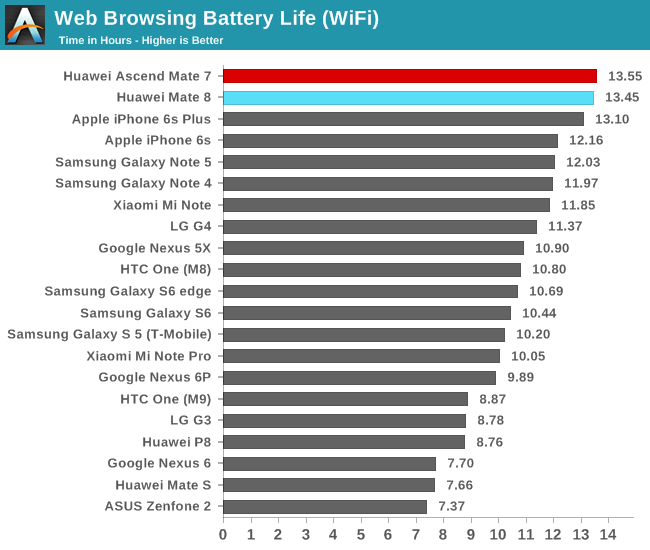
Starting off with our WiFi web-browsing test we see the Mate 8 just get short of 13.5h of battery life. The interesting comparison is here to last year’s Mate 7 as it seems the actually last just as much. This may point out that the screen efficiency measured in our display power testing was maybe correct and the Mate 8 is less efficient. Another aspect is that the Mate 8’s overall platform power consumption hasn’t seen much improvement and thus still represents a large barrier for battery life.
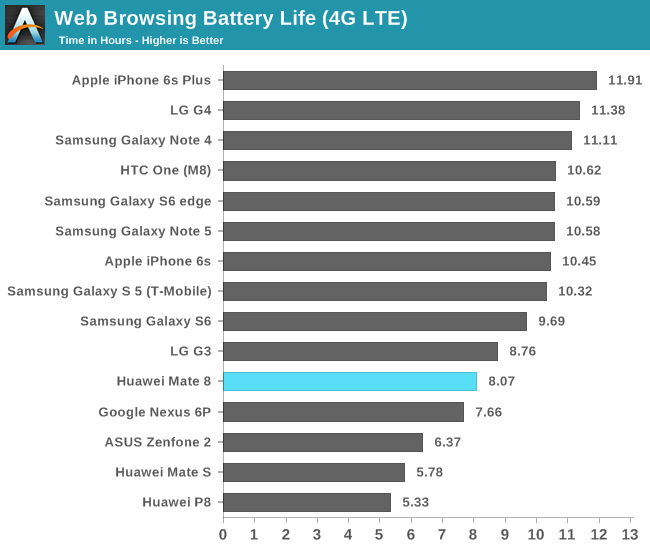
On the 4G LTE test we see that the Mate 8 loses out its advantage over the competition. Again I’m testing under rather mediocre signal conditions so it’s not a valid apples-to-apples comparison to devices reviewed by Joshua or Brandon, however when comparing it against for example such as the Nexus 6P which was tested under the same conditions we see that the Mate 8 faces a much larger battery life degradation going from the WiFi to the LTE test. The reason for this can only be that the Kirin 950’s modem and RF back-end just aren’t as efficient as Qualcomm or even Samsung’s.
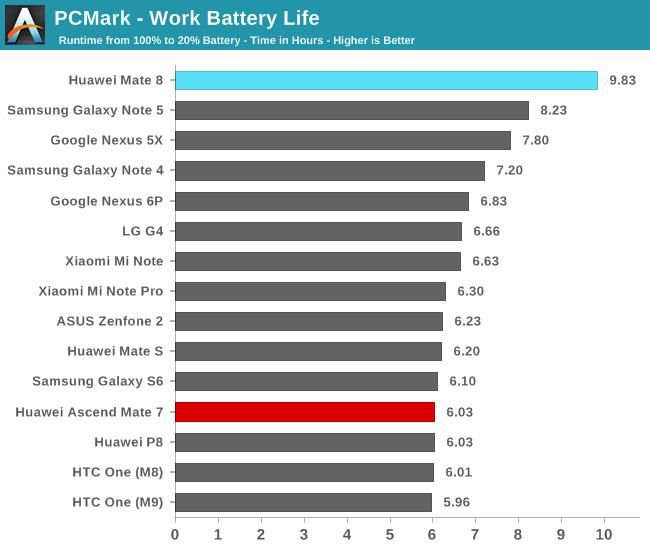
While the web-browsing tests didn’t represent a large improvement for the Mate 8, we see PCMark put the phablet as the current undisputed leader among high-performance devices. Here the difference to the Mate 7 is almost 4 hours, or around a 65% increase in battery life. The increase is most certainly linked to the new SoC’s power efficiency.
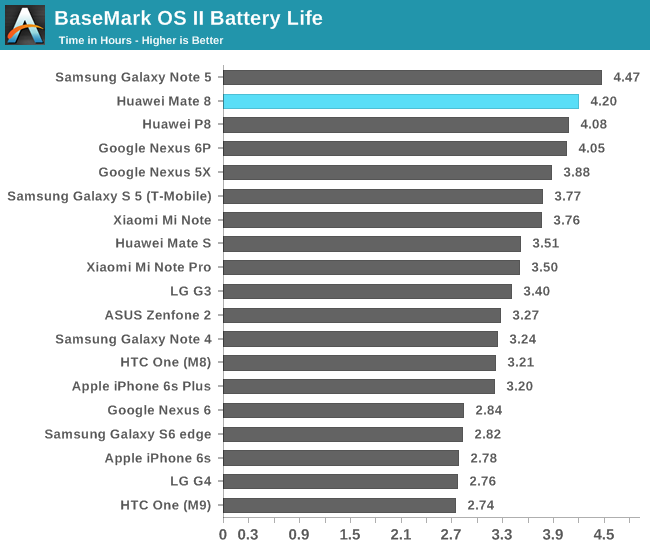
BaseMark OS II’s battery test is more of a maximum load type test that depends on the allowed maximum TDP of the phone. With a 15.2Wh battery and a runtime of 4.2h we see an average consumption of 3.6W, roughly the same amount of power that I saw that the device was able to sustain in our CPU thermal test.

Finally the GFXBench battery test shows that the Mate 8 doesn’t show very good battery life but this is a two-edged sword. As we’ve seen in the GPU section the SoC hardly throttles under heavy GPU load and thus retains its maximum performance for the duration of the test. Considering that the Mate 7 slowed throttled down to 9-10fps and the Mate 8 does not go under 40fps, it still shows that the Mate 8 is twice as efficient as the Mate 7 even though overall battery life is almost twice as short.
At 200 nits the Mate 8 averages an idle power consumption of 989mW and we saw that system load power for the T-Rex test is 3.64W. 3 hours battery runtime averages 5W of power, near the 4.6W we theorized. The small difference may be due to the overhead of actually running the on-screen test and thus also not able to show the DDIC’s savings thanks to PSR due to continuously changing screen content.
Overall I’ve been extremely impressed by the Mate 8’s battery life. In everyday usage this is the longest-lasting device I’ve had the opportunity to use. The Kirin 950’s efficiency is outstanding and is truly able to earn its place among the top for this generation. It seems the Mate 8’s limiting factors are related to the screen and general platform base power consumption, something that Huawei may be able to improve in future devices and thus get even better value out of the Kirin 950.
All being said, if you’re looking for a long-lasting device, you can’t go wrong with the Mate 8.
Charge Time
The Mate 8 advertises fast charging out of the box so that even considering it having a large 4000mAh battery, it should still be fast to fill up when in need. The stock charger is a 9V/2A (18W) unit. I’m not sure if the charging enumeration protocol is based on Quick Charge or Adaptive Fast Charging, but it was able to enable fast-charging on Samsung phones while the Mate 8 didn’t fast-charge on Samsung’s charger, meaning the Huawei charger is likely a Quick Charge unit and the Mate 8’s PMIC and voltage negotiation IC seems to only accept Quick Charge.
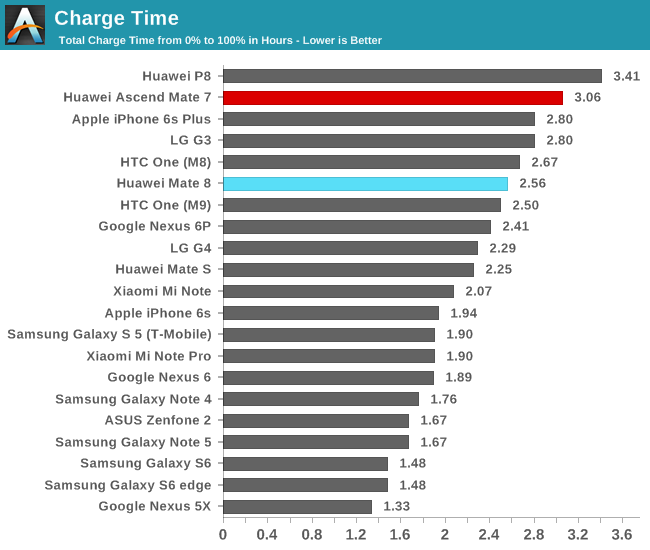
As we see in the charge graph, the Mate 8’s battery cell gets charged at up to 11.5W during the fast-charging phase, being able to reach 80% in 68 minutes around little under 40% charge for each half hour of charging. The last 20% takes up to another 70 minutes as the device switches over to trickle-charging.
While the Mate 8 ends up with total charge time of 2.56 hours, what counts is that the initial 80% of battery capacity can be charged very fast so the Mate 8 is no slouch in this metric.


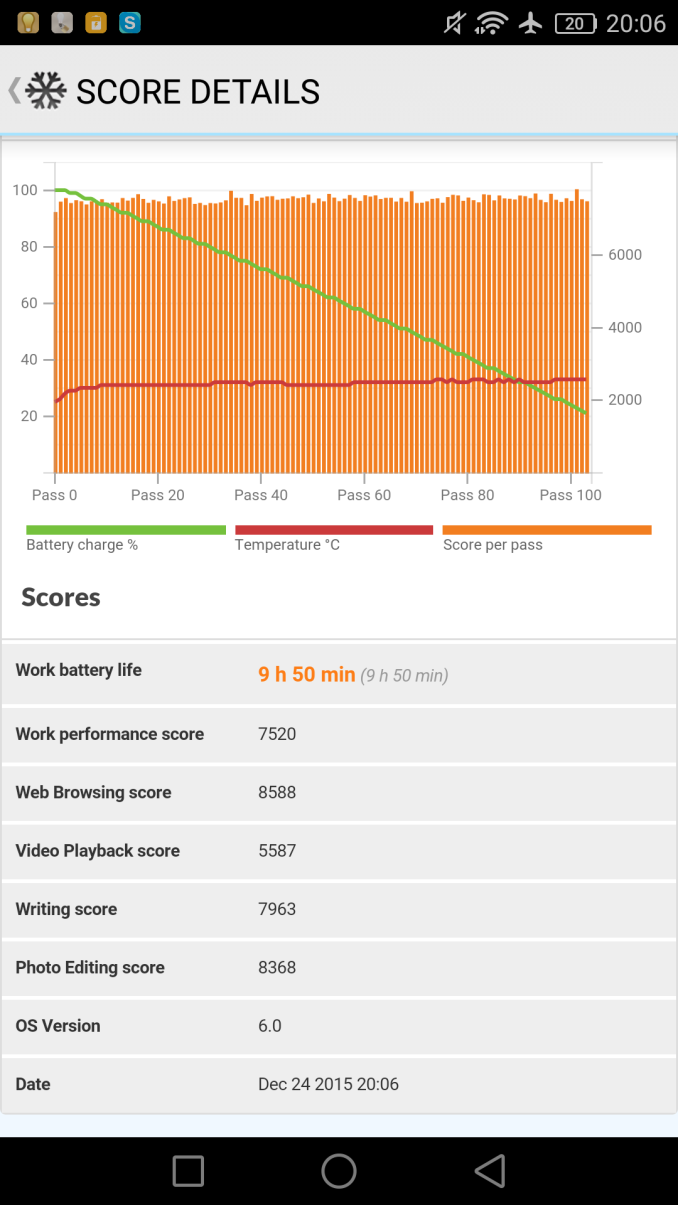
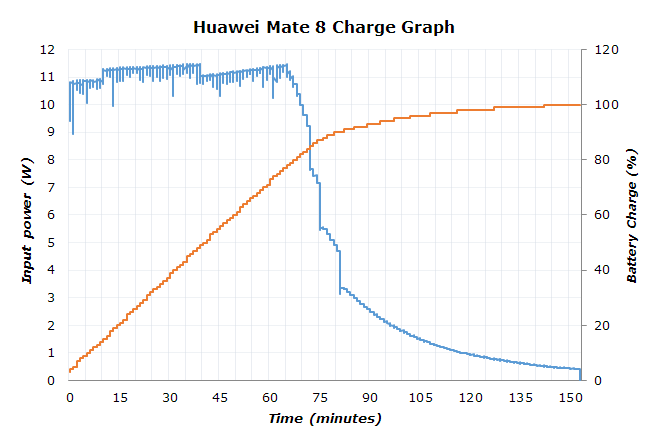








116 Comments
View All Comments
jay401 - Monday, January 11, 2016 - link
Mate 8? Why not just name it the "M8".huberddp - Monday, January 18, 2016 - link
I have a Nexus 6P and it never gets hot. Only the battery when charging.fanofanand - Tuesday, January 5, 2016 - link
$700+ for a Chinese device, yeah good luck with that. They really think people are going to choose this over a shiny new iPhone? They need to approach Western markets the way Hyundai and Toyota/Lexus did. Very few people will risk that kind of coin when there are proven alternatives available at the same price. That's why Lexus and Hyundai went with the "Everything the other guy has but 10% cheaper" kind of thing. If they were selling this phone for $450 people would take the risk, but I can't imagine this will be a smashing success in the West.beggerking@yahoo.com - Tuesday, January 5, 2016 - link
i take my $100 Blu phone over any icrap any day.niva - Tuesday, January 5, 2016 - link
I'm more concerned about the software on these phones than anything else. The reason why the Nexus 6P is doing so well is because Google manages their software and people are inclined to trust that process. Any other phones by Huawei will not sell well here, especially at those high prices.johnny_boy - Tuesday, January 5, 2016 - link
Huawei is pretty good from my experience. I own a Honor 6 and it got a relatively timely update to lollipop last year (though you need to download it from the Indian support site). There is reportedly Marshmallow update plans scheduled for this year, too. If this device gets Marshmallow, that will be quite impressive.Ethos Evoss - Wednesday, January 6, 2016 - link
Yes I just purchased Honor 6 Plus just for £120 and it is very good phone..Marshmallow is coming on both honor 6 and plus so that is awesome ! http://forum.xda-developers.com/honor-6/general/hu...
The sound is NOT good as on Vivo X5Pro but that IPS screen .aah whites are much much better still than ON AMOLED.. I really can't wait to receive S6 edge to compare the whites and the brightness
s.yu - Saturday, January 16, 2016 - link
Stupid Huawei fanboy you don't even know how to make a proper comparison. If you need the "blazing" white as some put it, using adaptive mode solves it. If you want an accurate white, there are basic and AMOLED photo modes.Ethos Evoss - Sunday, January 24, 2016 - link
You ashole qhy I would be fanboy?of this phone? When I have iPhone 6,s6 edge ,vivox5pro, P7 ..I just ignore you kiddo ;)
SanX - Thursday, January 7, 2016 - link
Generally agree. I tried Blu 6" 1080p not for $100 but for $200 as a temporal substitute. Aside from speed in games it was OK. Of course Nexus 6 is better but not that much really. And the screen of Blu is way brighter. Every next gen of cheapo phones make all other phones more and more marginally different. Advantages? You do not care to lose or drop them. Companies must think of allowing multiple phones with the same phone # so that we will never search for the misplaced phones LOL